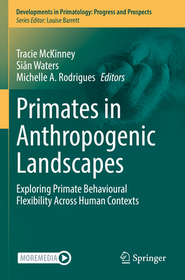
Primates in Anthropogenic Landscapes
Exploring Primate Behavioural Flexibility Across Human Contexts
Sorozatcím: Developments in Primatology: Progress and Prospects;
-
12% KEDVEZMÉNY?
- A kedvezmény csak az 'Értesítés a kedvenc témákról' hírlevelünk címzettjeinek rendeléseire érvényes.
- Kiadói listaár EUR 58.84
-
24 403 Ft (23 241 Ft + 5% áfa)
Az ár azért becsült, mert a rendelés pillanatában nem lehet pontosan tudni, hogy a beérkezéskor milyen lesz a forint árfolyama az adott termék eredeti devizájához képest. Ha a forint romlana, kissé többet, ha javulna, kissé kevesebbet kell majd fizetnie.
- Kedvezmény(ek) 12% (cc. 2 928 Ft off)
- Kedvezményes ár 21 475 Ft (20 452 Ft + 5% áfa)
Iratkozzon fel most és részesüljön kedvezőbb árainkból!
Feliratkozom
24 403 Ft

Beszerezhetőség
Megrendelésre a kiadó utánnyomja a könyvet. Rendelhető, de a szokásosnál kicsit lassabban érkezik meg.
Why don't you give exact delivery time?
A beszerzés időigényét az eddigi tapasztalatokra alapozva adjuk meg. Azért becsült, mert a terméket külföldről hozzuk be, így a kiadó kiszolgálásának pillanatnyi gyorsaságától is függ. A megadottnál gyorsabb és lassabb szállítás is elképzelhető, de mindent megteszünk, hogy Ön a lehető leghamarabb jusson hozzá a termékhez.
A termék adatai:
- Kiadás sorszáma 1st ed. 2023
- Kiadó Springer International Publishing
- Megjelenés dátuma 2024. január 3.
- Kötetek száma 1 pieces, Book
- ISBN 9783031117381
- Kötéstípus Puhakötés
- Lásd még 9783031117350
- Terjedelem346 oldal
- Méret 235x155 mm
- Súly 557 g
- Nyelv angol
- Illusztrációk XIII, 346 p. 36 illus., 29 illus. in color. Illustrations, black & white 525
Kategóriák
Hosszú leírás:
The field of primatology has expanded substantially in the last twenty years, particularly with regard to studies of primates in human-altered landscapes. This text aims to review the recent literature on anthropogenic (of human origin) influences on non-human primates, bringing an overview of this important area of primatology together for students. Chapters are grouped into three sections, representing the many ways anthropogenic activities affect primate populations. The first section, ‘Human Influences on Primate Habitat’, covers ways in which wild primates are affected by human actions, including forest fragmentation, climate change, and the presence of dogs. Section two, ‘Primates in Human-Dominated Landscapes’, looks at situations where non-human primates and humans share space; this includes primates in urban environments, primate tourism, and primates in agroecosystems. The final section, ‘Primates in Captivity’, looks at primate behaviour and welfare in captive situations, including zoos, the primate pet trade, and in entertainment.
Tartalomjegyzék:
Introduction.- Part 1-Human Influences on Primate Habitats.- Forest Fragmentation.- Primates in Regenerating Forest.- Responses of primates to roads: Dispersal barriers, mortality, and secondary effects.- Hunting by humans.- Primate-dog interactions.- Primate Tourism.- Infectious disease.- Climate change impacts on non-human primates – what have we modelled and what do we do now?.- PART 2: PRIMATES IN HUMAN-DOMINATED LANSCAPES.- Community-based conservation strategies to promote primate conservation in agricultural landscapes.- Translocated primate populations.- Translocated primate populations.- Exploring the human-primate interface.- Planning primate conservation in shared landscapes.- Non-pathogenic influences on primate health and behaviour.- PART 3: PRIMATES IN CAPTIVITY.- Anthropogenic and observer effects on primate behaviour: Perspectives on the continuum of wild-captive behaviour.- The primate pet trade.- Rescue, rehabilitation, and reintroduction.
Több



